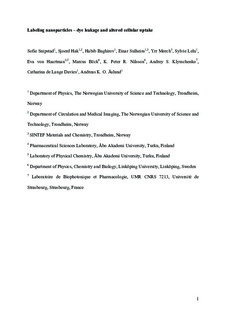| dc.contributor.author | Snipstad, Sofie | |
| dc.contributor.author | Hak, Sjoerd | |
| dc.contributor.author | Baghirov, Habib | |
| dc.contributor.author | Sulheim, Einar | |
| dc.contributor.author | Mørch, Ýrr Asbjørg | |
| dc.contributor.author | Lelu, Sylvie | |
| dc.contributor.author | von Haartman, Eva | |
| dc.contributor.author | Bäck, Marcus | |
| dc.contributor.author | Nilsson, Peter R | |
| dc.contributor.author | Klymchenko, Andrey S | |
| dc.contributor.author | Davies, Ruth Catharina de Lange | |
| dc.contributor.author | Åslund, Andreas | |
| dc.date.accessioned | 2017-10-25T06:42:36Z | |
| dc.date.available | 2017-10-25T06:42:36Z | |
| dc.date.created | 2016-09-27T09:53:13Z | |
| dc.date.issued | 2016 | |
| dc.identifier.issn | 1552-4922 | |
| dc.identifier.uri | http://hdl.handle.net/11250/2461974 | |
| dc.description.abstract | In vitro and in vivo behavior of nanoparticles (NPs) is often studied by tracing the NPs with fluorescent dyes. This requires stable incorporation of dyes within the NPs, as dye leakage may give a wrong interpretation of NP biodistribution, cellular uptake, and intracellular distribution. Furthermore, NP labeling with trace amounts of dye should not alter NP properties such as interactions with cells or tissues. To allow for versatile NP studies with a variety of fluorescence-based assays, labeling of NPs with different dyes is desirable. Hence, when new dyes are introduced, simple and fast screening methods to assess labeling stability and NP–cell interactions are needed. For this purpose, we have used a previously described generic flow cytometry assay; incubation of cells with NPs at 4 and 37°C. Cell–NP interaction is confirmed by cellular fluorescence after 37°C incubation, and NP-dye retention is confirmed when no cellular fluorescence is detected at 4°C. Three different NP-platforms labeled with six different dyes were screened, and a great variability in dye retention was observed. Surprisingly, incorporation of trace amounts of certain dyes was found to reduce or even inhibit NP uptake. This work highlights the importance of thoroughly evaluating every dye–NP combination before pursuing NP-based applications. © 2016 International Society for Advancement of Cytometry | nb_NO |
| dc.language.iso | eng | nb_NO |
| dc.publisher | Wiley | nb_NO |
| dc.title | Labeling nanoparticles: Dye leakage and altered cellular uptake | nb_NO |
| dc.type | Journal article | nb_NO |
| dc.description.version | submittedVersion | nb_NO |
| dc.source.journal | Cytometry Part A | nb_NO |
| dc.identifier.doi | 10.1002/cyto.a.22853 | |
| dc.identifier.cristin | 1386078 | |
| dc.relation.project | Norges forskningsråd: 220005 | nb_NO |
| dc.relation.project | Norges forskningsråd: 230788 | nb_NO |
| dc.description.localcode | This is the pre-peer reviewed version of the following article: [Labeling nanoparticles: Dye leakage and altered cellular uptake], which has been published in final form at [http://onlinelibrary.wiley.com/doi/10.1002/cyto.a.22853/abstract;jsessionid=48604612BF43C980D083EA32BE13FF97.f03t02]. This article may be used for non-commercial purposes in accordance with Wiley Terms and Conditions for Self-Archiving. | nb_NO |
| cristin.unitcode | 194,66,20,0 | |
| cristin.unitcode | 194,65,25,0 | |
| cristin.unitname | Institutt for fysikk | |
| cristin.unitname | Institutt for sirkulasjon og bildediagnostikk | |
| cristin.ispublished | true | |
| cristin.fulltext | preprint | |
| cristin.qualitycode | 1 | |
